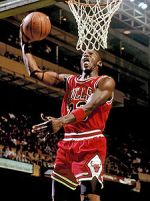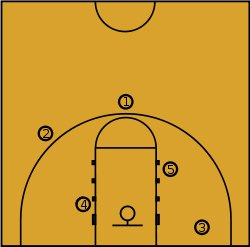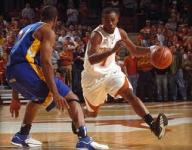Basketball is the most popular sport in the Philippines, played on both the amateur and professional levels.
Basketball is a team sport in which two teams of five players try to score points by throwing or “shooting” a ball through the top of a basketball hoop while following a set of rules. Basketball is one of the world’s most popular and widely viewed sports.
A regulation basketball hoop consists of a rim 18 inches (45.7 cm) in diameter and 10 feet (3.05 m) high mounted to a backboard. A team can score a field goal by shooting the ball through the hoop during regular play. A field goal scores two points for the shooting team if a player is touching or closer to the hoop than the three-point line, and three points (a “3 pointer”) if the player is “outside” the three-point line. The team with more points at the end of the game wins, but additional time (overtime) may be issued when the game ends with a tie. The ball can be advanced on the court by bouncing it while walking or running (dribbling) or passing it to a teammate. It is a violation (traveling) to walk with the ball, carry it, or to double dribble (to hold the ball and then resume dribbling).
Various violations are generally called “fouls“. Disruptive physical contact (a personal foul) is penalized, and a free throw is usually awarded to an offensive player if he is fouled while shooting the ball. A technical foul may also be issued when certain infractions occur, most commonly for unsportsmanlike conduct on the part of a player or coach. A technical foul gives the opposing team a free throw.
Basketball has evolved many commonly used techniques of shooting, passing, and dribbling, as well as specialized player positions and offensive and defensive structures (player positioning) and techniques. Typically, the tallest members of a team will play “center”, “small forward>”, or “power forward” positions, while shorter players or those who possess the best ball handling skills and speed play “point guard” or “shooting guard”.
While competitive basketball is carefully regulated, numerous variations of basketball have developed for casual play. Competitive basketball is primarily an indoor sport played on carefully marked and maintained basketball courts, but less regulated variations are often played outdoors in both inner city and rural areas.
Common Techniques and Practices
Positions
Although the rules do not specify any positions whatsoever, they have evolved as part of basketball. During the first five decades of basketball’s evolution, one guard, two forwards, and two centers or two guards, two forwards, and one center were used. Since the 1980s, more specific positions have evolved, namely:
1. point guard: usually the fastest player on the team, organizes the team’s offense by controlling the ball and making sure that it gets to the right player at the right time.
2. shooting guard: creates a high volume of shots on offense; guards the opponent’s best perimeter player on defense.
3. small forward: often primarily responsible for scoring points via cuts to the basket and dribble penetration; on defense seeks rebounds and steals, but sometimes plays more actively.
4. power forward: plays offensively often with their back to the basket; on defense, plays under the basket (in a zone defense) or against the opposing power forward (in man-to-man defense).
5. center: uses height and size to score (on offense), to protect the basket closely (on defense), or to rebound.
The above descriptions are flexible. On some occasions, teams will choose to use a three guard offense, replacing one of the forwards or the center with a third guard. The most commonly interchanged positions are point guard and shooting guard, especially if both players have good leadership and ball handling skills.
Strategy
The strategies also evolve with the game. In the 1990s and early 2000s, teams played with more “isolation”. Teams that had one superstar would let one player, usually the point guard or shooting guard, run most of the offense while the other four offensive players get out of his/her way. Nowadays, teams tend to play with more teamwork. The “Center” position has evolved to become more of a taller “Small Forward” position. Since teams play more teamwork, ball movement has evolved with the game, and more jump shots have been taken as a result.
There are two main defensive strategies: zone defense and man-to-man defense. In a zone defense, each player is assigned to guard a specific area of the court. In a man-to-man defense, each defensive player guards a specific opponent. Man-to-man defense is generally preferred at higher levels of competition, as it is intuitively easier to understand and avoids mismatches between players who play different positions. However, zone defenses are sometimes used in particular situations or simply to confuse the offense with an unexpected look.
Offensive plays are more varied, normally involving planned passes and movement by players without the ball. A quick movement by an offensive player without the ball to gain an advantageous position is a cut. A legal attempt by an offensive player to stop an opponent from guarding a teammate, by standing in the defender’s way such that the teammate cuts next to him, is a screen or pick. The two plays are combined in the pick and roll, in which a player sets a pick and then “rolls” away from the pick towards the basket. Screens and cuts are very important in offensive plays; these allow the quick passes and teamwork which can lead to a successful basket. Teams almost always have several offensive plays planned to ensure their movement is not predictable. On court, the point guard is usually responsible for indicating which play will occur.
Defensive and offensive structures, and positions, are more emphasized in higher levels in basketball; it is these that a coach normally requests a time-out to discuss.
Shooting
Shooting is the act of attempting to score points by throwing the ball through the basket. Methods can vary with players and situations.
The two most common shots that use the above described setup are the set shot and the jump shot. The set shot is taken from a standing position, with neither foot leaving the floor, typically used for free throws. The jump shot is taken while in mid-air, when the ball is released near the top of the jump. This provides much greater power and range, and it also allows the player to elevate over the defender. Failure to release the ball before the feet return to the ground is considered a traveling violation.
Another common shot is called the layup. This shot requires the player to be in motion toward the basket, and to “lay” the ball “up” and into the basket, typically off the backboard (the backboard-free, underhand version is called a finger roll). The most crowd-pleasing and typically highest-percentage accuracy shot is the slam dunk, in which the player jumps very high and throws the ball downward, straight through the hoop.
Another shot that is becoming common is the “circus shot.” The circus shot is a low-percentage shot that is flipped, heaved, scooped, or flung toward the hoop while the shooter is off-balance, airborne, falling down, and/or facing away from the basket.
A shot that misses both the rim and the backboard completely is referred to as an air ball. A particularly bad shot, or one that only hits the backboard, is jocularly called a brick.
Rebounding
The objective of rebounding is to successfully gain possession of the basketball after a missed field goal or free throw, as it rebounds from the hoop or backboard. This plays a major role in the game, as most possessions end when a team misses a shot. There are two categories of rebounds: offensive rebounds, in which the ball is recovered by the offensive side and does not change possession, and defensive rebounds, in which the defending team gains possession of the loose ball. The majority of rebounds are defensive, as the team on defense tends to be in better position to recover missed shots.
Passing
A pass is a method of moving the ball between players. Most passes are accompanied by a step forward to increase power and are followed through with the hands to ensure accuracy.
A staple pass is the chest pass. The ball is passed directly from the passer’s chest to the receiver’s chest. A proper chest pass involves an outward snap of the thumbs to add velocity and leaves the defence little time to react.
bounce pass Here, the passer bounces the ball crisply about two-thirds of the way from his own chest to the receiver. The ball strikes the court and bounces up toward the receiver. The bounce pass takes longer to complete than the chest pass, but it is also harder for the opposing team to intercept (kicking the ball deliberately is a violation). Thus, players often use the bounce pass in crowded moments, or to pass around a defender.
overhead pass is used to pass the ball over a defender. The ball is released while over the passer’s head.
outlet pass occurs after a team gets a defensive rebound. The next pass after the rebound is the outlet pass.
no-look pass is the passing of the ball without looking at the receiving teammate.
behind-the-back pass which, as the description implies, involves throwing the ball behind the passer’s back to a teammate.
Dribbling is the act of bouncing the ball continuously with one hand, and is a requirement for a player to take steps with the ball. To dribble, a player pushes the ball down towards the ground with the fingertips rather than patting it; this ensures greater control.
A skilled player can dribble without watching the ball, using the dribbling motion or peripheral vision to keep track of the ball’s location. By not having to focus on the ball, a player can look for teammates or scoring opportunities, as well as avoid the danger of having someone steal the ball away from him/her.
Blocking
A block is performed when, after a shot is attempted, a defender succeeds in altering the shot by touching the ball. In almost all variants of play, it is illegal to touch the ball after it is in the downward path of its arc; this is known as goaltending.
To block a shot, a player has to be able to reach a point higher than where the shot is released. Thus, height can be an advantage in blocking. Players who are taller and playing the power forward or center positions generally record more blocks than players who are shorter and playing the guard positions. However, with good timing and a sufficiently high vertical leap, even shorter players can be effective shot blockers.
“http://en.wikipedia.org/wiki/Basketball”




Recent Comments